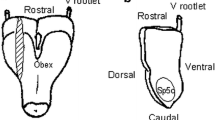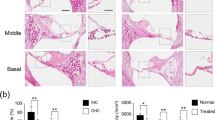Summary
Spatial extent and duration of the functional blockade elicited by intracerebral injection of tetrodotoxin (TTX) was examined in rats anesthetized with pentobarbital. Pupillary diameter was measured under dissecting microscope before and up to 24 h after injection of TTX (10 ng/l μl saline) into or 1.0, 1.5 and 2.0 mm lateral from the Edinger-Westphal nucleus. TTX administration elicited mydriasis the latency of which was directly and amplitude indirectly proportional to the target-injection distance. The maximum mydriasis attained 3.4 mm, lasted 2 h and slowly decayed over subsequent 20 h. Impulse transmission and conduction was blocked in a spherical volume of tissue about 3 mm in diameter the development of which could be approximated by diffusion from an instantaneous point source. Completeness and full reversibility make the TTX block a convenient research tool.
Similar content being viewed by others
References
Bures J, Buresova O (1990) Reversible lesions allow reinterpretation of system level studies of brain mechanisms of memory. Concepts Neurosci 1:69–89
Buresova O, Fifkova E, Bures J (1966) Pupillary paralysis evoked by thalamic spreading depression in rats. Exp Brain Res 2:168–175
Cahill L, Coopersmith RM, Leon M, McGaugh JL (1987) Local injection of tetrodotoxin decreases metabolic activity in discrete brain regions: a 2-deoxyglucose autoradiography analysis. Soc Neurosci Abstr 13:1414
Carslaw HS, Jaeger JC (1959) Conduction of heat in solids. Oxford University Press, New York
Catterall WA (1984) The molecular basis of neuronal excitability. Science 223:653–661
Fifkova E, Marsala J (1967) Stereotaxic atlases for the cat, rabbit and rat. In: Bures J, Petran M, Zachar J (eds) Electrophysiological methods in biology. Academic Press, New York, pp 653–731
Flicker C, Geyer MA (1982) Behavior during hippocampal microinfusions. III. Lidocain versus picrotoxin. Brain Res Rev 4:129–136
Frey JM, Chinn KC, Bianchi CP, Narahashi T (1988) Differential sensitivities to Na+-current blockade by TTX and cocaine in N1E-115 and rat dorsal root ganglion (DRG) cells. Soc Neurosci Abstr 14:835
Gardner-Medwin AR (1983) Analysis of potassium dynamics in mammalian tissue. J Physiol 335:393–426
Harlan RE, Shivers BD, Pfaff DW (1983) Estrogenic maintenance of lordotic responsiveness: requirement for hypothalamic action potentials. Brain Res 268:67–78
Ivanova SF, Bures J (1990) Acquisition of conditioned taste aversion in rats is prevented by tetrodotoxin blockade of a small midbrain region centered around the parabrachial nuclei. Physiol Behav 48:543–549
Kaneda M, Oyama Y, Ikemoto Y, Akaike N (1989) Blockade of the voltage-dependent sodium current in isolated rat hippocampal neurons by tetrodotoxin and lidocaine. Brain Res 484:348–351
King FA, Marchiava PL, Moruzzi G (1963) The time course of the mydriatic response to darkness in the midpontine pretrigeminal cat. Arch Ital Biol 101:545–551
Lipton SA, Harcourt P (1984) The effect of tetrodotoxin on the death of mammalian retinal ganglion cells. Soc Neurosci Abstr 10:1081
Lomax P (1966) The distribution of morphine following intracerebral microinjection. Experientia 22:249–250
Myers RD (1966) Injection of solutions into cerebral tissue: relation between volume and difusion. Physiol Behav 1:171–174
Narahashi T (1972) Mechanism of action of tetrodotoxin and saxitoxin on excitable membranes. Fed Proc 31:1124–1132
Proudfit HK (1980) Reversible inactivation of raphe magnus neurons: effects on nociceptive thresholds and morphine induced analgesia. Brain Res 201:459–464
Rigdon GC, Pirch JH (1984) Microinjections of procaine or GABA into the nucleus basalis magnocellularis affects cue-elicited unit responses in the rat frontal cortex. Exp Neurol 85:283–296
Robertson RT, Ambe RK, Yu J (1989) Intraocular injections of tetrodotoxin reduce transiently expressed acetylcholin esterase activity in developing visual cortex. Dev Brain Res 46:69–84
Rothfeld JM, Harlan RE, Shivers BD, Pfaff DW (1986) Reversible disruption of lordosis via midbrain infusions of procaine and tetrodotoxin. Pharmacol Biochem Behav 25:857–863
Sandkuhler J, Maisch B, Zimmermann M (1987) The use of local anesthetic microinjections to identify central pathways: a quantitative evaluation of the time course and extent of the neuronal block. Exp Brain Res 68:168–178
Shatz J, Stryker MP (1986) Tetrodotoxin infusion prevents the formation of eye-specific layers during prenatal development of the cat's retino-geniculate projection. Soc Neurosci Abstr 12:589
Stryker MP, Harris WA (1986) Binocular impulse blockade prevents the formation of ocular dominance columns in cat visual cortex. J Neurosci 6:2117–2133
Thompson R (1983) Brain systems and long term memory. Behav Neural Biol 37:1–45
Author information
Authors and Affiliations
Additional information
Visiting scientist from the Institute of Evolutionary Physiology and Biochemistry, Academy of Sciences, Leningrad, USSR.
Rights and permissions
About this article
Cite this article
Zhuravin, I.A., Bures, J. Extent of the tetrodotoxin induced blockade examined by pupillary paralysis elicited by intracerebral injection of the drug. Exp Brain Res 83, 687–690 (1991). https://doi.org/10.1007/BF00229849
Received:
Accepted:
Issue Date:
DOI: https://doi.org/10.1007/BF00229849




